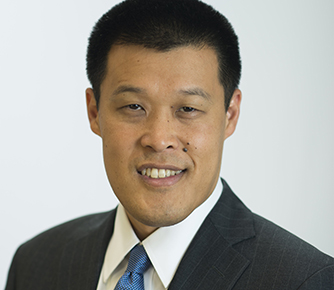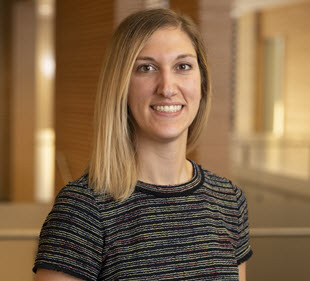Dr. Stephen Cha, Chief Medical Officer, is a practicing physician whose experiences and perspectives help inform COVID-19 vaccination efforts. As the liaison for critical clinical initiatives, his strategic efforts are helping to improve public awareness of the vaccine.
Having worked in state and county health departments, Stephanie Wilkinson, Director of Policy for Community Integration, brings her experience working in public health into more traditional areas of health care. She is an active participant in a new program focused on building vaccine confidence across the nation.
Many state and county health departments say when public health is working, nothing happens. That is to say, when public health is effective, our normal lives are rather uneventful.
Take, for example, county public health departments, which are tasked with inspecting food service establishments. If these departments do not adequately perform their jobs, we would undoubtedly endure regular food borne illness outbreaks. And in many cases, the success of public health has led to the belief that extra resources aren't needed, resulting in drastic budget cuts.
Now, as we work on the front lines to promote and encourage a new vaccine and bring an end to a global pandemic, our habit of taking public health for granted means we have even more work to do as a nation. Vaccine success depends on wide community acceptance and high vaccination rates to reduce the infection level. However, there are many individuals, especially those enrolled in Medicaid and who live in communities hit hardest by the pandemic, who are hesitant to get in line to receive the COVID-19 vaccine.
Communities hit hardest by COVID-19 show more hesitancy
Black Americans have been disproportionately impacted by COVID-19, having experienced 2.8x more deaths and 3.7x more hospitalizations compared to White populations, since the onset of the pandemic. Many within this population are considered essential workers, which puts them at a higher risk of being exposed to the virus. Black, Indigenous and people of color (BIPOC) populations are also less likely to have access to sufficient health care, and are more likely to live in overcrowded living conditions and experience negative social impacts as a result of COVID-19, such as food insecurity or housing instability.
In addition to being disproportionately impacted by COVID-19, high percentages of Black Americans are indicating that they do not plan to get the COVID-19 vaccine. According to our February Consumer Demographic Analysis, only 51% of Black Americans plan to get the COVID-19 vaccine compared to 75% of White Americans. Distrust in health care for Black Americans stems deeper than vaccines alone, due in part to the strong belief that racial discrimination is widespread in health care — including a history of medical experimentation on Black populations. But if Black Americans do not receive the vaccination, these individuals will continue to live with a higher risk of being hospitalized or dying from the virus.
Many Medicaid beneficiaries face additional challenges that could contribute to low vaccination rates. For some, the fear of having to pay for the vaccination, or a lack of transportation to a vaccination site, is a barrier. Others remain unsure of when they can actually receive the vaccine. To help combat these concerns, we're making sure to communicate that members will have no cost-sharing responsibility for the COVID-19 vaccine, meaning it is free for them to receive. For transportation concerns, we're working with local partners to bring vaccine delivery sites closer to members and identifying potential transportation solutions for those who remain farther away. We are also continuing to monitor state prioritization plans to best inform our members when they will be eligible to receive the vaccine.
Some individuals have cultural or religious-based hesitancies driven by personal morals and beliefs. The vaccine’s quick development has put its safety and efficacy into question, leaving many unwilling to receive it or waiting to see how it works out for others before committing. These hesitations will slow acceptance of the vaccine and make it difficult to raise vaccination rates. Only by working in partnership with trusted voices and organizations that communities feel they can trust can we strengthen confidence in the data on the safety and efficacy of the various vaccine options and broaden the acceptance of vaccines as a whole.
Utilizing existing community-based relationships
For vaccine-hesitant populations, we must work to build confidence and instill trust in the vaccine. This is often best done through familiar sources, which is why we are using our established relationships with community- and faith-based organizations across the nation, as well as forming new partnerships to help promote the vaccine. We are also using existing UnitedHealth Group initiatives, such as our STOP COVID program, which was rolled out in several cities across the country to support COVID-19 testing. Because these programs rely heavily on partners such as churches, local community health centers, and other community leaders to deliver educational resources to their communities, we can leverage these relationships again to help educate Medicaid beneficiaries and instill trust in the vaccine.
Different populations are vaccine hesitant for different reasons, meaning there is no "one size fits all" approach to promote the COVID-19 vaccine. To ensure all hesitations are addressed, it's important to tailor messages for specific populations and localities. Our community partnerships are critical in this effort, as they can craft messages to address the specific hesitations and needs of the communities they serve. Throughout the COVID-19 vaccination campaign, we will continue to strive to amplify and empower the voices and faces of trusted community leaders.
We are committed to improving access to factual information about the vaccine — whether these resources come directly from UnitedHealthcare or through our local community partners. By communicating the importance of the COVID-19 vaccine, in combination with credible educational resources, we can help the Medicaid population make the educated, informed decision to get vaccinated.
Herd immunity requires a large percentage of the population to be vaccinated
Several generations cannot remember a time when diseases like polio were active and life-threatening to the general population in the United States. And the reason we cannot remember is due in large part to vaccine development. Vaccines have gotten us out of past pandemics, but even to build herd immunity against polio it required approximately 80% of the population to be vaccinated. (For comparison, only half of individuals older than six months received the flu shot during the 2018 – 2019 flu season.) So while we do not know just how many people will need to receive the COVID-19 vaccine to achieve herd immunity, helping individuals understand the importance of receiving the vaccine will be a large task that requires increased participation from organizations outside the health system.
Extending vaccine efforts beyond COVID-19
Many diseases are prevented through immunizations given to children at their early well-child visits. But we have seen a decline in appointment attendance during the pandemic. While this decline can partially be associated with pandemic-related stay-at-home orders, the continued lag as stay-at-home orders are relaxed or lifted shows a reluctance to visit health care settings out of fear of contracting COVID-19. This means that fewer children are receiving regular immunizations that normally protect our population against preventable diseases like measles and whooping cough.
As children begin to return to school or see friends and family, we could see a resurgence of these diseases as unvaccinated children begin to share spaces. So as we stress the importance of the COVID-19 vaccine, we will also look for opportunities to expand our messaging to promote all vaccinations as well as other important preventive care.
The partnerships and lessons we learn while working with communities and providers to educate individuals about the COVID-19 vaccine can be used to tackle other public health challenges and sources of inequity, such as maternal mortality and opioid use disorder. By capitalizing on the public health work we do today, we can help improve population health and reduce health disparities moving forward.

